History
The Valley Bulldog breed can be traced back to the mid 1900s; although it is possible that it may have existed much earlier. Research has shown that several of today's breeders have produced ten to fifteen generations of pure Valley Bulldogs in their breeding programs.
The genetic origin and foundation of the Valley Bulldog was established on and incorporated the Bulldog and the Boxer. These two breeds were used to incorporate the Boxer's athletic ability and exceptional temperament and the Bulldog's courageous and unwavering spirit. Over the years type has been set and the Valley Bulldog is now a pure bred in both form and type.
The Valley Bulldog was bred as a durable, athletic, working utility dog that was used primarily for farm and ranch work. Valley Bulldogs were used to work cattle and other unruly livestock as well as protect and guard the farm or ranch and its occupants from natural predators.
All of these needs and others have lent to the development of this courageous and durable breed. It should be remembered that the Valley Bulldog of today is truly a working breed. International Olde English Bulldogge Association. Retrieved on 2007-01-21.
Breed standards
General Description: The perfect Valley Bulldog should be of medium height and size with a large broad head, sturdy muscular body with a thick neck of short to medium length. The Valley Bulldog possesses a broad chest and shoulder area and a thick powerful rear end. Valley Bulldogs should have an excellent temperament and can be quite intelligent. The temperament is to be very stable and trustworthy. Their disposition should be outgoing, playful yet protective when needed.
Head: Large and broad, deeply sunken between the eyes (medial furrow). The circumference of the head should be equal to or greater than the dog's height at the shoulder. Fault: Head too small.
Muzzle: Broad, deep and of medium to short in length. The bite is undershot. Fault: Muzzle too long (more than 3 inches), scissor or even bite.
Eyes: Wide apart and of moderate size. Any color is acceptable. Fault: Completely white / pink rims.
Nose: From the stop to the end of the nose must be at least an inch. Fault: Completely pink nose (a small amount is acceptable).
Neck: Short to Medium in length. Should be thick and muscular.
Chest: Ribs should be well sprung (rounded) and the chest wide and deep. Fault: Too narrow in the chest.
Back: Medium length with a slight rise from the shoulders to the rump (level back is just as acceptable).
Legs: Forelegs should be stout and wide apart, neither bowing out or turning in. Fault: Bowing or turned out resulting in poor movement.
Feet: Round and the pasterns should be strong. Fault: Down in the pasterns or splayed feet.
Height: Males - 15 to 18 inches at the shoulder. Females - 14 to 18 inches at the shoulder.
Weight: Between 45 to 70 lbs. No penalty for dogs above the standard weight as long as the dog is well proportioned.
Color: Various brindles with or without white, white (solid white not preferred), tan, fawn or red. The coat should be short and smooth.
Ears: Short either button or rose.
Tail: Down to hock naturally or screwed. May be docked, of no major importance. International Olde English Bulldogge Association. Retrieved on 2007-01-21.
Temperament
The Valley Bulldog is a loyal and intelligent companion. They desire to be close to their owner at all times and will enjoy intense playtime or rest and relaxation with their owners. Valleys are great companions for the entire family and take very well to small children. Occasionally, you may find a Valley Bulldog that has inherited the Boxer's tendency to be rough at play and may also be quite a jumper. This is a rare occurrence, but should be noted for those owners with small children.
Health
The incorporation of the Boxer with the Bulldog corrected most of the health problems associated with the Bulldog. However, they may suffer from minor breathing problems if their snubbed snout restricts air. In these cases, they should be monitored in hot weather to prevent heat stroke. Valley Bulldogs may be susceptible to minor skin irritations during adolescent stages of growth. The skin irritations are easily corrected and most often disappear once the dog has reached full maturity. They breed and whelp their own litters without any intervention.
Photo gallery
 Vizsla / Hungarian Vizsla
Vizsla / Hungarian Vizsla

The Hungarian Vizsla, pronounced VEEZH-la (zh as in vision), is a dog breed originating in Hungary. Vizslas are known as excellent hunting dogs, and also have a level personality making them suited for families. The Hungarian Wirehaired Vizsla was created by cross-breeding the Hungarian Shorthaired Vizsla with the German Wirehaired Pointer during the 1930s.
Appearance
General appearance
The Vizsla is a medium-sized hunting dog of distinguished appearance and bearing. Robust but rather lightly built; They are lean dogs, and have defined muscles, and are similar to a Weimaraner. The tail is normally docked to two-thirds or one quarter of the original length.
Colour and coats
The coat of both varieties is a golden-rust color. The coat could also be described as a copper/brown color, russet gold and dark sandy gold. Small areas of white on the fore-chest and on the toes are permissible but undesirable.
In the wirehaired variety the coat is wiry, close-lying, strong, and dense. ¾ of an inch to 1¼ inch (2-3 cm) in length with a dense, water-repellent undercoat. The outline of the body is not to be hidden by the longer coat. Pronounced eyebrows along with a strong, harsh beard, ¾ of an inch to 1¼ inch (2-3 cm) long on both sides of the muzzle reinforce the determined expression. The coat should never be long, soft, silky, shaggy, crinkle, woolly, thin, lacking undercoat or lacking brushes on the legs.
Size
The Vizsla is a medium-sized dog, and fanciers feel that large dogs are undesirable. Wirehaired Vizslas are normally slightly taller than smoothhaired Vizslas. The average height and weight:
- Males
- Height: 22 - 25 inches (56 - 63.5 centimetres)
- Weight: 45 - 65 pounds (20 - 29 kilograms)
- Females
- Height: 21 - 24 in. (53 - 61 cm)
- Weight: 40 - 55 lb (18 - 25 kg)
Temperament
Vizslas are lively, gentle-mannered, loyal, caring and highly affectionate. They quickly form close bonds with their owners, including children. Often they are referred to as "velcro" dogs because of their loyalty and affection. They are quiet dogs, only barking if necessary or provoked.
They are natural hunters with an excellent ability to take training (American Breed Standard, AKC). Not only are they great pointers, but they are excellent retrievers as well. They will retrieve on land and in the water, making the most of their natural instincts. However, they must be trained gently and without harsh commands or strong physical correction, as they have sensitive temperaments and can be easily damaged if trained too harshly (Gottlieb, 1992). Vizslas are excellent swimmers and often swim in pools if one is available. Like all gun dogs, Vizslas require a good deal of exercise to remain healthy and happy. Thirty minutes to an hour of exercise daily in a large off-leash area is optimal (Coffman 1992).
The Vizsla thrives on attention, exercise, and interaction. It is highly intelligent, and enjoys being challenged and stimulated, both mentally and physically. Vizslas that do not get enough attention and exercise can easily become destructive or hyperactive. Under-stimulated Vizslas may also become depressed or engage in obsessive-compulsive behaviours such as persistent licking (Coffman 1992). Vizslas are very gentle dogs that are great around children.
The Vizsla is totally unsuited to being kept outside, since unlike most other breeds, it does not have an undercoat. This lack of undercoat makes the Vizsla susceptible to the cold so it must not be kept in a kennel or left outside for extended periods of time. The Vizsla wants to be close to its owner as much of the time as possible. Many Vizslas will sleep in bed with their owners if allowed, burrowing under the covers. They are self-cleaning dogs and only need to be bathed five or six times a year, and are somewhat unique in that they have little noticeable "dog smell" detectable by humans. After several forays into lakes and streams they will develop an aroma that is a weaker version of the 'wet dog' smell. A quick bath and this odor will vanish. Lack of undercoat also means Vizslas are hypoallergenic .
History
Smooth-haired history
The origin of the Vizsla can be traced back to very early times in Hungarian history. Ancestors of today's Vizsla were the toy dogs used by the Magyar tribes living in the Carpathian Basin from the 9th century on. They were widely used for hunting rats.
The first written reference to Vizsla dog breed has been recorded in the Illustrated Vienna Chronicle prepared on order of King Lajos the Great (Louis the Great) by the Carmelite Friars in 1357 (Boggs, 2000:17).
Vizslas faced and survived several near-extinctions in their history, including being overrun by English Pointers and German Shorthair Pointers in the 1800s (Boggs, 2000:19) and again to near-extinction after World War II (Boggs, 2000:21).
The Vizsla was used in development of other breeds, most notably the Weimaraner and German Shorthair Pointer breeds (Boggs, 2000:18). There is much conjecture about those same breeds, along with other pointer breeds, being used to reestablish the Vizsla breed at the end of 19th century. (Boggs, 2000:19). In either case the striking resemblance between the three breeds is indisputable.
Wirehaired history
The Wirehaired Vizsla is a separate breed from its common smooth-coated cousin. The Hungarian Wirehaired Vizsla was created in the 1930s by the interbreeding of the Vizsla and the German Wirehaired Pointer to get a dog with a heavier coat, suitable for working in the colder weather. The Wirehaired Vizsla is recognized by the FCI, CKC, UKC, and the KC (UK). Currently there are fewer than 400 Wirehaired Vizslas in the United States.
Common Illnesses
Although the Vizsla is not generally considered as a sickly dog, breeding from a small number of dogs has led to heritable illnesses in some offspring, including:
- dysphagia-megaoesophagus (difficulty swallowing, drooling and muscle wasting)
- hip dysplasia
- hypothyroidism
- sebaceous adenitis
- digestive problems (including intolerance to certain foods or food allergies)
- eye conditions such as:
- ectropion (loose eyelids which give the look of "droopy eyes")
- entropion (where the hairy skin around the eye rubs against the eye)
- idiopathic epilepsy is becoming more common in this breed (Gottlieb 2002)
Responsible breeders do not select dogs for breeding if they have such inherent problems.
Vizsla in the U.K.
Approximately 1,000 Vizsla puppies are registered with the Kennel Club of Great Britain (KC) each year, making the breed one of the top 50 most popular. The number is steadily rising year on year as more people recognise the breed. At least two breed clubs for the Vizsla exist in Britain.
Vizsla in the U.S.
Frank J. Tallman and Emmett A. Scanlan imported Vizsla Sari as the first Vizsla in the United States of America.
Sari and her two pups (Tito and Shasta) were delivered by a TWA cargo plane to Kansas City via New York from Rome on October 7, 1950. (Boggs, 2000:23). Sari was later bred with Vizsla Rex. The male Vizsla Rex del Gelsimino, born 8/1/49, was purchased for $75 in food, clothing, medicine, and other supplies thanks to an Belgrade's US Embassy employee M.M. Yevdjovich who provided the direct connection to the owner in Stapar, Serbia to Tallman's representative Harry R. Stritman. Rex understood German and Hungarian commands and the claim has been made of history dating back to 1730 although never verified through a Serbian dog book in Yugoslavia.
Rex was delivered by a TWA cargo plane to Kansas City via New York via Brussels from Belgrade on June 12, 1951. (Boggs, 2000:26) There is a bit of controversy about Rex's official breeder, verbatim from (Boggs, 2000:26): "The Yugoslavia Kennel Club offered to give temporary registration to Vizslas at a local dog show so as to register future blood lines since many of the dogs in Yugoslavia and behind the Iron Curtain were pure bred, but without registration papers."
The American Kennel Club recognized Vizsla as the 115th breed on November 25, 1960.
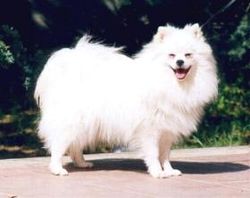
A Volpino Italiano is a white, spitz-type breed of dog originally from Italy, and modern Switzerland.
History
Spitz-type dogs were found throughout the ancient world. Specimens from this group have been found preserved in European peat bogs which anthropologists trace to 4000 BC. The remains—with curly tails, foxy heads, and small erect ears—have been found dating back over 5,000 years. These little pets wore decorative ivory bracelets and collars. Engravings of similar dogs were found in Greece, and these have been determined to date to about 400 BC.
The Volpino has been known and loved by Italian royalty for centuries, being a special favorite of the ladies. Although bearing a strong resemblance to the Pomeranian, the breed is much older and thus has a different background. The northern dogs found their way south very early in the history of domesticated dogs. The Italian word for wolf is lupo, and the Keeshond is called both Lupino and Volpino in Italian. Volpe is Italian for "fox", hence volpino means little fox in Italian. Despite his long history, the Volpino is unknown outside of Italy and is now quite rare even in his homeland.
Despite its small size, this dog was originally kept as a guard dog. Its job was to alert the large mastiffs to an intruder. However, due to their lovely temperament and intelligence they also became popular as pets. For unknown reasons the breed's popularity dropped and in 1965 the last dogs were registered. In 1984 an attempt was made to revive the breed. The dogs still living as guard dogs on farms became the new breeding stock. Volpinos remain rare with about 2000 dogs world wide. Most are in Italy but some people are now breeding them in Scandinavia, the UK and the USA. A 2006 survey of kennel clubs found an average of 120 puppies registered each year in Italy (with ENCI) and a total of 200-300 registered each in Sweden, Norway and Finland. Fewer than one dozen were registered in the USA with UKC and CKC.
German Shorthaired Pointer

The German Shorthaired Pointer is a breed of dog developed in the 1800s in Germany for hunting. This gun dog was developed by crossing the old Spanish pointer with a number of other breeds and breed types including scent hounds, tracking hounds, French Braques, and English Pointer to create a lean, athletic, and responsive all around hunting dog. Some authorities consider it to be the most versatile of all gun dogs and its intelligence and affectionate nature make it a popular companion dog for active owners.
Appearance
The breed is streamlined in build yet powerful with strong hindquarters that make it able to move rapidly and turn quickly. It has moderately long flop ears set high on the head. Its muzzle is long, broad, and strong, allowing it to retrieve even heavy furred game. Its profile should be straight or strongly Roman-nosed; any dished appearance to the profile (such as seen in the Pointer) is incorrect. The eyes are generally brown, with darker eyes being desirable; yellow or "bird of prey" eyes are a fault. The tail is commonly docked, although this is now prohibited in some countries. Docking is performed different than it is done in other dog breeds, where only the part after where the caudal vertebrae start to curl are docked, leaving enough to let the dog communicate through tail wagging and movement. Like all German Pointers, they have webbed feet.
Coat and color
The German Shorthaired Pointer's coat is short and flat. It should have a dense undercoat protected by stiff guard hairs that makes the coat water resistant and better suited to cold weather than that of the English Pointer for example. The color can be a dark brown, correctly referred to in English as liver (incorrectly called chocolate or chestnut), black (although any area of black is cause for disqualification in American Kennel Club sanctioned shows), or either color with white. Commonly the head is a solid or nearly solid color and the body is speckled or ticked with liver and white, sometimes with saddles or large patches of solid color. Roan coats are also common, with or without patching. While the German standard permits a slight sandy coloring ("Gelber Brand") at the extremities, this is extremely rare, and a dog displaying any yellow coloring is disqualified in AKC and CKC shows.
Size
Various breed standards set its height at the withers anywhere between 21 and 25 inches, making this a medium breed. Adults typically weigh from 45 to 70 lbs (22 to 32 kg), with the female being usually slightly shorter and lighter than the male.
Temperament
Since the German shorthaired pointer was developed to be a dog suited to family life and as well as a versatile hunter, the correct temperament is that of an intelligent, bold, and characteristically affectionate dog that is cooperative and easily trained. Shyness, fearfulness, over submissiveness, aloofness, lack of biddability, or aggression (especially toward humans) are all incorrect traits. It is usually very good with children, although care should be taken because the breed can be boisterous especially when young. These dogs love interaction with humans and appreciate active families who will give them an outlet for their energy. Most German Shorthaired Pointers make excellent watchdogs. The breed generally gets along well with other dogs. A strong hunting instinct is correct for the breed, which is not always good for other small pets such as cats or rabbits. With some training, however, it is not unusual for this highly intelligent breed to quickly discern what is prey and what is not, and they can live quite amicably with housecats and the like.
The German Shorthaired Pointer needs plenty of vigorous activity. This need for exercise (preferably off lead) coupled with the breed's natural instinct to hunt, means that training is an absolute necessity. The German shorthaired pointer's distinctly independent character and superior intelligence makes this breed best suited to experienced owners who are confident and capable handlers.
Lack of sufficient exercise and/or proper training can produce a German Shorthaired Pointer that appears hyperactive or that has destructive tendencies. Thus the breed is not a suitable pet for an inactive home or for inexperienced dog owners. The most common cause of death for German Shorthaired Pointers is being hit by a car. Although these dogs form very strong attachments with their owners, a dog that receives insufficient exercise may feel compelled to exercise himself. These dogs can escape from four foot and sometimes six foot enclosures with little difficulty. Regular hunting, running, carting, bikejoring, skijoring, mushing,dog scootering or other vigorous activity can alleviate this desire to escape. Its natural instinct to hunt may result in occasional dead strays, such as cats, rats, pigeons and other urban animals, if not taken to hunting trips often or if not taught to distinguish among what is prey and what is not.
Like the other German Pointers (the German Wirehaired Pointer and the less well known German Longhaired Pointer), this is one of the few hunting breeds that can perform virtually all gundog roles. It is pointer and retriever, an upland bird dog and water dog, can be used for hunting larger and more dangerous game, and in addition has a scent hound's talented nose. It is an excellent swimmer but also works well in rough terrain. It is tenacious, tireless, hardy, and reliable. In short, it is a superb all-around field dog that remains popular with hunters of many nationalities.
This is an intelligent and highly trainable breed. Like the other versatile breeds, the German shorthaired pointer was developed to be comparatively independent and thoroughly capable of working out of sight of its handler. This independence can lead to the dog appearing to have a mind of its own, and so this breed especially requires training to ensure that it understands that the owner is in charge. The dog may, at times, instinctually claim to be the owner of the hunt. Along with its superb hunting ability and companionable personality, its superior intelligence and biddability (trainability) continue to make this one of the more popular large breeds.
During hunting sessions, a completely instinctive scent-hiding activity through rubbing against carrion can be observed.
Health
The Shorthaired Pointer is generally a healthy breed. Epilpetic seizures have been a problem in some lines, and a few individuals may suffer from hip dysplasia, genetic eye diseases, skin disorders and cancerous lesions in the mouth, on the skin and other areas of the body. Most German Shorthaired Pointers are tough, healthy dogs, but according to Margo B. Maloney DVM (NAVHDA Versatile Hunting Dog Magazine, April, 2003) the breed can be subject to a number of hereditary disorders just as any other purebred.
Unexplained swelling and growth of the nipples by age in males, if not sensitive to the touch, are considered normal in this breed and is fairly common. Although a biopsy can reveal more, a simple check by any veterinarian is sufficient. Occasional bleeding may suggest infection or cancer.
As with any other hunting dog, contact with game can cause the spread of fungi that can easily colonise in the gums and bacteria which can cause infections on open wounds and small cuts from scratching against plants and bushes during a regular hunting session.
Care
Its short coat needs very little grooming, just occasional brushing. The dog should be bathed only when needed.
Like all dogs with flop ears, it can be prone to ear infections and its ears require regular checking and cleaning. It has a longer life expectancy than many breeds of this size, commonly living 12 to 14 years, with individual dogs living to 16 to 18 years not uncommon.
As it is a large, active breed, it can require considerable food; however, it can also become obese if too much food is given for its activity level. A healthy weight should permit the last two ribs to be felt under the coat, and the dog should have a distinct waist or "tuck-up".
Due to its short coat, body heat management is easier compared to other breeds. However, the breed-specific high levels of activity require the breed to drink considerable amounts of water to prevent dehydration. Early symptoms of dehydration show itself as thick saliva and urine with an excessively strong and distinct smell.
History
The German Shorthaired Pointer is descended from the old Spanish Pointer, which was taken to Germany in the 1600s. From that time until the first studbook was created in 1870, however, it is impossible to identify all of the dogs that went into creating this breed. Most-likely candidates for its ancestors include local German breeds such as other hunting dogs, the schweisshund, an early German tracking hound, the Foxhound, various French hounds, assorted Scandinavian breeds, the German Bird Dog, and the Italian Pointer. It is generally accepted that no Bloodhound was used as foundation material. In the late 1800s, breeders included the English Pointer to the foundational breeding program, adding style and run to round out the breed's all-around versatility as a hunting dog. Prince Albrecht zu Solms-Braunfeld of the Royal House of Hanover was credited with encouraging breeders to select early specimens on the basis of function rather than form. It is believed that this enlightened guidance was instrumental in making the breed what it is today.
Modern breeds similar in form and function (but not in color) to the German Shorthaired Pointer include the copper-russet Viszla and the silver-beige or blue-black Weimaraners.
In art and literature
Robert B. Parker's most popular mystery series features a Boston detective known only as Spenser who has had a series of three solid-liver German Shorthairs, all named Pearl: one who stood with him during a bear charge in his rural youth; one given to his girlfriend by her ex-husband; and the third Pearl, to keep company with Spenser and his girlfriend in their late middle age. Author Parker appears on many of the Spenser dustjackets with a solid-liver GSP bitch identical to the three incarnations of Pearl in the series.
Rick Bass's ruminations on living and hunting with a German Shorthaired Pointer in Montana can be found in the book Colter: The True Story of the Best Dog I Ever Had.
Sportswriter Mel Wallis' memoir Run, Rainey, Run, explores the extraordinary relationship he had with an extremely intelligent and versatile hunting German Shorthaired Pointer.
The logo of the American Kennel Club is a Pointer, not a German Shorthaired Pointer, though frequently mistaken for the latter.
Simon the Pointer by Joan Brown captures the personality of pointing dogs, however, this book is about an English Pointer, not a German Shorthaired Pointer.

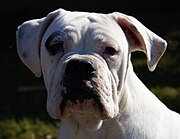









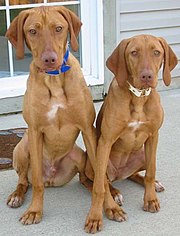





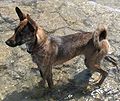

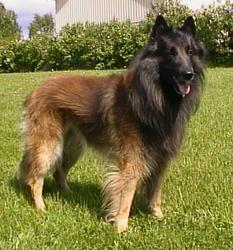








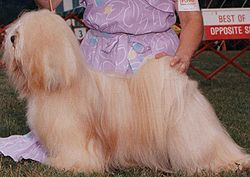
























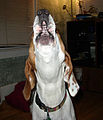







![Validate my Atom 1.0 feed [Valid Atom 1.0]](valid-atom.png)









